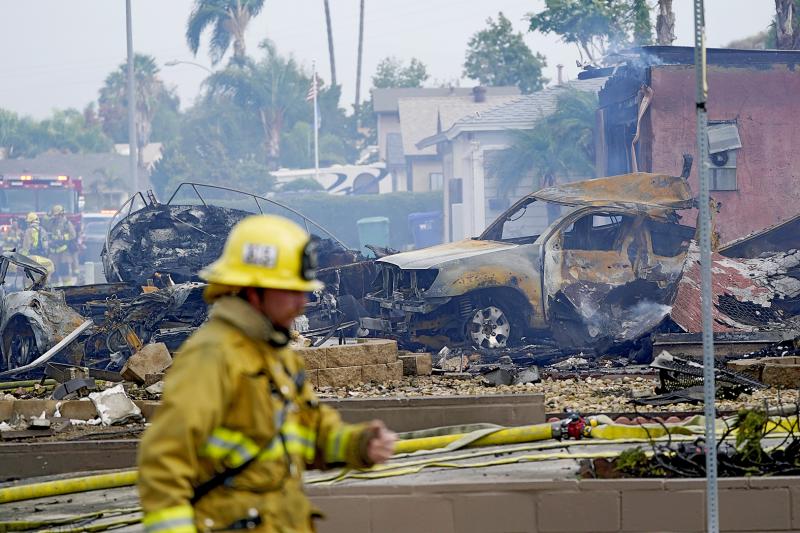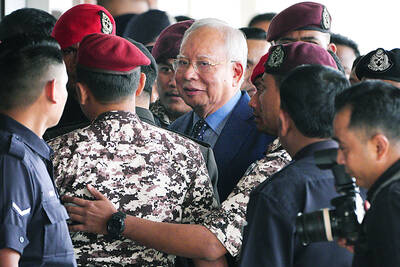Before a twin-engine airplane nose-dived into a suburb in San Diego, California, an increasingly concerned air traffic controller told the pilot more than a half-dozen times that he needed to gain altitude, a recording that is to be among the evidence examined by US federal investigators who arrived on Tuesday at the crash scene.
The Cessna 340 smashed into a UPS van, killing the driver, and then hit two houses just after noon on Monday in Santee, a suburb with a population of 50,000 people east of San Diego.
The pilot, Sugata Das, died and an elderly couple sustained burns when their home went up in flames.

Photo: AP
No one was inside at the second residence when the crash occurred.
Former US National Transportation Safety Board (NTSB) investigator Al Diehl said that the recording between air traffic control and Das indicates that he was trying to deal with a major distraction or significant emergency on his own, breaking a basic rule that aviators should always tell controllers everything.
“The first thing you do when you’re in trouble is call, climb and confess — and he did not do any of the three,” Diehl said. “These are very basic rules that flight instructors tell their students.”
Diehl, who helped design a Cessna cockpit, said that the twin-engine aircraft has a complex system that could lead to deadly mistakes.
Clouds and windy weather might have complicated Das’ ability to handle the aircraft, Diehl added.
Investigators are also to look at whether there could have been a medical emergency, something an autopsy should help reveal.
Robert Katz, a certified flight instructor, said that he believed Das “was totally disoriented.”
Katz said the clouds were low enough that the pilot had to use an instrument landing system on his approach.
“In my opinion, he was clearly disoriented at that point,” Katz told CBS8 in San Diego. “He did not know which way was up.”
An NTSB investigator arrived at the crash scene on Tuesday morning and would review radar data, weather information, air traffic control communication, airplane maintenance records and the pilot’s medical records, agency spokeswoman Jennifer Gabris said.
Das worked at Yuma Regional Medical Center in Arizona and was flying from there to Montgomery-Gibbs Executive Airport in San Diego, where he lived.
Before the crash, when the plane was about 800m from the runway, an air traffic controller alerted Das that the aircraft was too low.
On a recording made by LiveATC, a Web site that monitors and posts flight communications, the air controller repeatedly warns Das that he needs to climb in altitude.
He also cautioned that a C-130, a large military transport plane, was overhead and could cause turbulence.
Das responded that he was aware.
The controller is later heard saying: “It looks like you’re drifting right of course, are you correcting?”
“Correcting,” Das said.
Das asks if he has been cleared for the runway.
The controller says: “I need you to fly,” warning him that he is coming in too low.
Das tells him he is climbing.
The controller urges him to climb again, and Das says he is ascending.
“Ok. It looks like you’re descending, sir. I need to make sure you are climbing, not descending,” the controller says.
Then the controller speaks with more urgency.
“Low altitude alert, climb immediately, climb the airplane,” he says. “Climb the airplane please.”
The controller repeatedly urged the plane to climb to 1,524m, and when it remained at 457m, the controller said: “You appear to be descending again, sir.”
There is no response.
Diehl said that the plane at the last minute made a sweeping turn to the right as if trying to switch back to another airport that was closer because something was wrong, but Das did not mention that to air traffic control.
KGTV-TV posted video that the station said it received from a viewer showing the plane arcing in the sky and plunging into the neighborhood.
People a block away from the scene said their homes shook from the thunderous crash.

The death of a former head of China’s one-child policy has been met not by tributes, but by castigation of the abandoned policy on social media this week. State media praised Peng Peiyun (彭珮雲), former head of China’s National Family Planning Commission from 1988 to 1998, as “an outstanding leader” in her work related to women and children. The reaction on Chinese social media to Peng’s death in Beijing on Sunday, just shy of her 96th birthday, was less positive. “Those children who were lost, naked, are waiting for you over there” in the afterlife, one person posted on China’s Sina Weibo platform. China’s

‘NO COUNTRY BUMPKIN’: The judge rejected arguments that former prime minister Najib Razak was an unwitting victim, saying Najib took steps to protect his position Imprisoned former Malaysian prime minister Najib Razak was yesterday convicted, following a corruption trial tied to multibillion-dollar looting of the 1Malaysia Development Berhad (1MDB) state investment fund. The nation’s high court found Najib, 72, guilty on four counts of abuse of power and 21 charges of money laundering related to more than US$700 million channeled into his personal bank accounts from the 1MDB fund. Najib denied any wrongdoing, and maintained the funds were a political donation from Saudi Arabia and that he had been misled by rogue financiers led by businessman Low Taek Jho. Low, thought to be the scandal’s mastermind, remains

‘POLITICAL LOYALTY’: The move breaks with decades of precedent among US administrations, which have tended to leave career ambassadors in their posts US President Donald Trump’s administration has ordered dozens of US ambassadors to step down, people familiar with the matter said, a precedent-breaking recall that would leave embassies abroad without US Senate-confirmed leadership. The envoys, career diplomats who were almost all named to their jobs under former US president Joe Biden, were told over the phone in the past few days they needed to depart in the next few weeks, the people said. They would not be fired, but finding new roles would be a challenge given that many are far along in their careers and opportunities for senior diplomats can

Australian Prime Minister Anthony Albanese yesterday announced plans for a national bravery award to recognize civilians and first responders who confronted “the worst of evil” during an anti-Semitic terror attack that left 15 dead and has cast a heavy shadow over the nation’s holiday season. Albanese said he plans to establish a special honors system for those who placed themselves in harm’s way to help during the attack on a beachside Hanukkah celebration, like Ahmed al-Ahmed, a Syrian-Australian Muslim who disarmed one of the assailants before being wounded himself. Sajid Akram, who was killed by police during the Dec. 14 attack, and